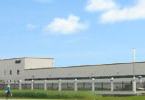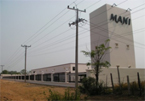Products
R&D

Around 1957

Around 1961
Our founder Masao Matsutani started a business at Takanezawa in Tochigi Prefecture on May 1, 1956 and established MATSUTANI SEISAKUSYO CO., LTD, in 1959.
After considering which industry would allow us to contribute to the world in spite of the firm’s rural location, he decided to engage in the medical field, where there were unmet needs. At that time, surgical needles made with steel were widely used in the medical field. However, rust caused a problem at the medical frontline, which he took particular note of. He therefore started research and development of 18-8 stainless steel eyed needles. A typical example of corrosion-resistant alloyed steel is stainless steel alloyed with chromium (18%) and nickel (8%).
From this developed our differentiating factor and our aim for the world's best quality.
| 1956 | Masao Matsutani independently started manufacturing and sales of eyed surgical needles made with steel in Takanezawa, Tochigi (now Takanezawa Factory). |
|---|---|
| 1959 |
Started the development of new technology to manufacture eyed surgical needles of 18-8 stainless steel and received subsidy from the Ministry of Health and Welfare for that technology.
Reorganized as a limited company with capital of up to 1 million yen. Registered the company name MATSUTANI SEISAKUSYO. |
| 1961 | Developed 18-8 stainless steel surgical needles. |
| 1962 | Became eligible for national subsidy from the Ministry of International Trade and Industry for export promotion of prototypes. |

1970 Takanezawa
Plant No.1
Following the research and development of stainless steel surgical needles, we began R&D for eyeless needles. Making use of the stainless steel needle technology developed for eyed needles, we developed pipe-attached needles followed by pipe-welded needles. Out of safety considerations, we undertook further research to find a way to produce a needle without pipe welding which would instead be fitted with a hole for thread attachment. At that time, competitors were processing needles with drills; however, it was difficult for us to perform the drilling process on our stainless steel material.
We finally reached the solution of using a laser beam to make the hole in the needle.
Only around ten years on from when the first laser was discovered in the U.S. in 1960, most people disagreed with the idea of using a very expensive laser machine for reasons of cost-effectiveness. However, we continued with research and development for laser drilling technology with an unwavering commitment to pursuing safety, and this became the foundation for MANI's subsequent development.
Meanwhile, we felt it was necessary to have products other than needles in order to continue and develop in business and tried manufacturing scalpels, which we thought would complement our product range as they are used in surgery alongside needles. However, we found that the production technology was completely different even though the distribution channels were the same. We possessed the wire processing technology to produce eyed or eyeless needles but not the sheet metal plate processing technology to produce scalpels. Our venture into a different field had failed and we ended up suffering a loss. Learning from that lesson, we made it our policy to focus on extra-fine medical instruments made from stainless steel wire. In other words, we now compete using our original technology within our area of specialty.
| 1966 | Concluded research contract with Japan Atomic Institute and started research on cobalt 60 gamma-ray sterilization of surgical sutures for the first time in Japan. Created MANI brand logo and set corporate color as yellow to support sales of pipe-fitted needle sutures. Capital four million JPY. |
|---|---|
| 1967 |
Started manufacturing and sales of eyeless surgical needles. Increasing exports in earnest.
Capital six million JPY. |
| 1970 | Built Plant No.1 at Takanezawa Factory. |
| 1972 | Developed laser-drilled eyeless surgical needle. |
| 1975 | Received Award for Excellence from Secretary General of Small and Medium Enterprise Agency at 14th Japan Trade Fair. Capital 20 million yen. |

1980 Takanezawa
Plant No.2
Following our development of eyed and eyeless needles, we entered the dental market in 1976 with tools for root canal treatment and barbed and smooth broaches.
At the same time, we strengthened existing products. As a result of R&D activities with eyed cutting needles, we succeeded in developing the "pentagon cut", which enhanced our differentiation from competing products and reinforced sales. We also aimed for steady improvement of quality by placing our presswork research and work-in-process inventory for eyed needles on a collaborative basis with the purpose of cost reduction. As the number of patent applications increased around 1980, we adopted a patent strategy to ensure future benefit which focused on acquiring industrially significant patents that pull away our competitors.
| 1976 | Started production and sales of barbed and square 18-8 stainless steel dental broaches. Entered dental market. |
|---|---|
| 1978 | Capital 30 million yen. |
| 1979 | Received Excellent Enterprise Award for prevention of public pollution. |
| 1980 | Built Plant No. 2 at Takanezawa Factory. Established export division. |
| 1982 | Started construction of LAN-based point-of-production system. |
| 1983 | Received Science and Technology Agency award for dental products. Started sales of dental reamers and files in Japan at FDI Dental Show in Tokyo. |
| 1984 | Received Patent Agency award for invention of dental instrument. Capital 48 million yen. |
| 1985 | Built meeting room building at Takanezawa Factory. |

1991 Takanezawa
Plant No.3

1993 Kiyohara Factory
established
In the years from 1986 to 1990, we established our Corporate Philosophy, Company Credo, Basic Management Policy, and Basic Business Policy.
"The best quality in the world, to the world ", established as our Basic Business Policy, is directed at our "output" of products and services. It derives from our founder's commitment to being "the best," adopted when the stainless steel eyed needle was developed soon after he started the business. It also implies that it is necessary for our products to be available to all the people of the world if they are indeed to be the world's best quality, and that we ought to feel responsible for depriving patients around the world of good medical treatment if we cannot distribute our products worldwide. In 1993, we entered the ophthalmic market with our sterilized ophthalmic suture. This is a finished product combining needle and thread (we also supply eyeless needles as a component to thread manufacturers). After their market launch, our sterilized ophthalmic sutures gained a good reputation for their excellent penetration, leading to a large market share within a few years.
| 1986 | Established Company Credo, Basic Management Policy, and Basic Business Policy. |
|---|---|
| 1988 |
Received 88th Patent of the Year Award from Patent Agency for invention of dental products.
Established Corporate Philosophy. |
| 1989 | Received Award of the Medium Business Research Institute. |
| 1991 | Built Plant No. 3 at Takanezawa Factory. |
| 1992 |
Received Patent Agency Award for design of manipler (surgical skin-stapler) in Kantō Invention Contest.
Capital 96 million JPY. |
| 1993 |
Completed Kiyohara factory at Kiyohara Industrial Park.
Started sales of maniplers, dental Peeso reamers, and ophthalmic sutures. Entered ophthalmic market. |
| 1995 | Relocated to new Kiyohara Factory. |

1996 MANI MEINFA
established

1999 MANI YANGON
established

2003 MANI HANOI
established
As the brand-name "MANI" came to be recognized with the expansion of our product sales, we changed our trade name from MATSUTANI SEISAKUSYO to MANI, INC.
We then established our manufacturing sites in Vietnam and Myanmar, aiming at quality improvement as well as reduction of production costs in the context of the very strong yen of 1995 and a change in Japanese work attitudes which meant that people were no longer willing to perform mundane tasks. Additionally, to improve transparency and facilitate business evaluation through the indicator of stock price, we had our stock registered. In 2004, we reformed our structure to become a company with committees.
| 1996 |
Changed company name to MANI, INC. Kanji Matsutani (then president) received Medal with Yellow Ribbon. Acquired ISO 9001 and CE Marking certification.
Established joint corporation MANI-MEINFA CO., LTD. in Hanoi (Vietnam). |
|---|---|
| 1997 | Built annex to Kiyohara Factory. |
| 1999 | Established MANI YANGON LTD. in Yangon, Myanmar. |
| 2000 | Won patent suit regarding infringement of surgical needle patent. Capital 323 million yen. |
| 2001 | Capital 665 million yen. Registered stock with the Japan Securities Dealers Association (JASDAQ). |
| 2002 | Built annex to Kiyohara Factory. |
| 2003 |
Built annex to MANI-MEINFA CO., LTD., Hanoi, Vietnam.
Established MANI HANOI CO., LTD., in Hanoi, Vietnam. |
| 2004 | Converted to company with committees. Acquired certification under ISO14001 (environmental management system) and OHSAS18001 (occupational safety and health management system). |

2009 MANI VIENTIANE
established
To avoid country risks, an additional production site was established in Laos as our third site following Vietnam and Myanmar. Additional sales bases were also established in Vietnam and China to reinforce marketing in developing countries.
we acquired all shares and ownership of GDF Gesellschaft für dentale Forschung und Innovationen GmbH, which is a leading company in dental restorative material in Germany, aiming for accelerating launch and introduction of new products in developed countries.
| 2006 | Relocated head office from Takanezawa Factory to Kiyohara Factory. |
|---|---|
| 2007 | Finished building annex to Kiyohara Headquarters and Factory. |
| 2008 | Received PORTER PRIZE 2008. |
| 2009 |
Established MANI VIENTIANE SOLE CO., LTD. in Vientiane (Laos).
Merged MANI-MEINFA CO., LTD. with MANI HANOI CO., LTD. |
| 2010 |
Established MANI MEDICAL HANOI CO., LTD in Hanoi (Vietnam).
Established MANI RESOURSES CO., LTD. in Utsunomiya (Japan). |
| 2011 | Listed on second section of the Tokyo Stock Exchange. |
| 2012 |
Listed on first section of the Tokyo Stock Exchange.
Established MANI Medical Beijing Co., Ltd. in Beijing (China). |
| 2015 | Acquired all shares and ownership of Schütz Dental Group (Schütz Dental GmbH and GDF Gesellschaft für dentale Forschung und Innovationen GmbH) (Germany). |
| 2017 | Established MANI MEDICAL INDIA PRIVATE LIMITED in Delhi (India). |
| 2017 | 2017 Built a new factory(MHC-PY2) in Vietnum. |
| 2018 | Transferred all shares and ownership of Schütz Dental GmbH (Germany). |
| 2022 | Transferred to prime market of the Tokyo Stock Exchange. |
| 2023 | Established MANI MEDICAL DEVICE MALAYSIA SDN. BHD. in Kuala Lumpur (Malaysia). |
| 2024 | Established MANI MEDICAL AMERICA, INC. in California (U.S.A.) |
| 2025 |
Established the Hanaoka Factory. MANI MEDICAL DEVICE MALAYSIA SDN. BHD. changes name to MANI ASIA SDN. BHD. Currently, positioned as the Asian regional headquarters. |